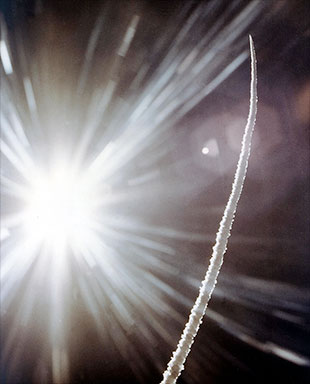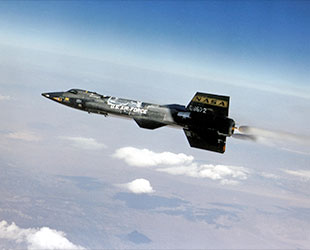August 23, 2005 — Between the years that NASA flew its first unmanned Mercury sub-orbital space flight and when its Apollo astronauts trained for their first mission to orbit the Moon, 12 test pilots flew the nation's first rocket plane to the edges of the atmosphere... and beyond.
Of the dozen, eight of those pilots flew the experimental X-15 to altitudes above 264,000 feet – 50 miles – a height recognized by the U.S. Air Force as being in space.
Of the eight, five pilots were employed by the Air Force and received their astronaut wings. The three others were NASA pilots and received no such honor.
On Tuesday (Aug. 23), that omission was rectified during a ceremony at NASA's Dryden Flight Research Center in California honoring the three civilian research pilots who flew the X-15 into space.
Astronaut wings were awarded to former NASA research pilots William H. "Bill" Dana and posthumously to John B. "Jack" McKay and Joseph A. Walker for their flights that exceeded 50 miles in altitude.
The private ceremony before an audience of 200 invited guests and Dryden employees, included presentations by Kent Rominger, NASA's Chief of the Astronaut Corps and by Johnny Armstrong, an X-15 test engineer and current Deputy Director of the Access to Space Office at the Air Force Flight Test Center, Edwards Air Force Base, Calif.
Among the guests were other X-15 pilots, including Scott Crossfield and Joe Engle. Engle received astronaut wings from the Air Force and flew the space shuttle as a NASA astronaut.
Unlike the Air Force wings, which are physically a metal pair of wings, the distinction that Dana and the families of McKay and Walker accepted were ceremonial in nature. Each received a certificate, a Velcro-backed badge of the type NASA astronauts adorn on their flight suits, and the actual flight logs from their now recognized spaceflights.
The honor officially establishes Walker as the 11th person to fly in space and the the 7th American by his first wings-qualifying flight on Jan. 17, 1963. McKay is now the 26th space explorer (13th U.S. astronaut) by his flight on Sept. 28, 1965. Dana ranks as the 35th human to leave Earth (and 21st American) by Nov. 1, 1966.
Of the three, McKay broke the 50-mile barrier once, Dana twice and Walker three times.
Two of Walker's fights also exceeded 328,000 feet (or 62 miles) altitude, the internationally-recognized boundary of space set by the Fédération Aéronautique Internationale.

The X-15 rocket-powered aircraft begins its climb after launch at the NASA Dryden Flight Research Center in California. (NASA) |
In total, 13 of the 199 X-15 flights reached space. Aside from the six spaceflights achieved by NASA pilots, seven others were flown by Air Force pilots Robert White, Robert Rushworth, Engle, William Knight and Michael J. Adams. Only three of the eight X-15 astronauts - White, Engle and Dana - are still living.
After flying the X-15 (including its final flight in October 1968), Dana served as a research pilot for the Air Force's X-20 Dyna-Soar program. He led NASA's lifting body test program during the late 1960s and 1970s. Dana served as Chief Engineer at NASA Dryden from 1993 to 1998, when he retired.
McKay joined NACA (the National Advisory Committee for Aeronautics), NASA's predecessor, in 1951 as a test pilot for the X-1 and D-558 and served as a project pilot on the F-100, F-102, F-104, and F-107 test programs before he was assigned to the X-15. He was seriously injured when the X-15 he was piloting crashed in 1962. McKay's death on April 27, 1975, stemmed from liver damage suffered in the accident.
Walker's altitude record of 67.1 miles set on the third of his X-15 spaceflights went unbroken by any other rocket plane until the privately-funded SpaceShipOne exceeded 69 miles in October 2004. Walker made the first test flight of the X-15 in 1960 and went on to fly a total of 24 times.
After the X-15, he tested the "flying bedstead," the Lunar Landing Research Vehicle, in advance of training NASA's Apollo astronauts how to touchdown on the moon. Walker was killed on June 8, 1966, when the F-104 chase plane he was piloting collided with the XB-70 "Valkyrie" he was chasing.

The X-15 in flight over the California desert in the 1960s. (NASA) |
The X-15 explored the realm of hypersonic flight during a nine year joint program between NASA, the U.S. Navy, the U.S. Air Force and North American. The X-15 was air launched from a B-52 aircraft before igniting its liquid-fuel rocket engine. In addition to setting altitude records, the experimental aircraft also achieved speed milestones in the Mach 4 to 6 range. The X-15 program is credited with contributing to the development of the Mercury, Gemini, and Apollo spacecraft as well as NASA's space shuttle.
